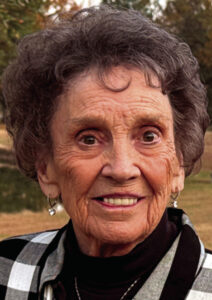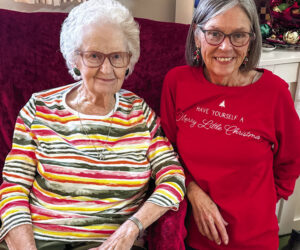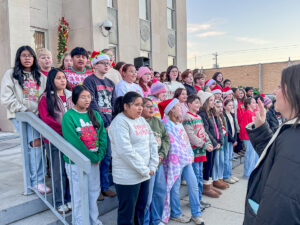Need for nurturing: Foster parents bridge gap for children in need
FRANKLIN LIVING—
More than 6,000.
More than 600.
That’s the approximate number of children in foster care and the average number of days spent in foster care in Alabama, respectively.
May is National Foster Care Awareness Month, shining a light on the system that connects loving families with children who have been removed from their homes by the Department of Human Resources, for any number of reasons. It’s a reality Leilani Johnson has seen firsthand from multiple angles, as a former DHR investigator and current foster home licensor for Franklin County.
In her role, she sees the pressing need for dedicated foster parents. “This morning alone I’ve received three emails from across the state looking for placements for foster children,” Johnson said. “It’s a need throughout the state.”
The process that leads to a child entering the foster care system is probably familiar to most, at least in a general sense. When someone makes a report to DHR that a child is in any type of unsafe living conditions – whether that’s proximity to illicit substances, contact with an abusive caretaker or lack of minimal acceptable shelter and sanitation – DHR investigators step in to assess the risk of harm to the child. If DHR determines the child needs to be removed from the home, it will first work with parents to arrange for the child to go to a family member or neighbor.
If that isn’t possible, Johnson explained, that’s where the foster care system comes in to bridge the gap, with foster parents serving in a temporary role while the child’s primary guardians work to get their problems straightened out.
“We teach our foster parents, reunification is our No. 1 goal,” Johnson said. “We have to give those parents the opportunity to work toward getting their children back. That’s our No. 1 goal, always.”
That’s a reality some who consider foster parenting can’t accept. Foster mother Amy McCollum has heard it all before.
“People say ‘I couldn’t do it. I’d get too attached,’” said McCollum, who first connected with the foster care system in 2013. “You have to get attached. If you’re not attached to them, you’re not taking good care of them.”
McCollum, a teacher at Phil Campbell High School, became interested in fostering after seeing one of her students go through the experience of having her child placed in foster care. Remembering the ultimate goal – reunification – helps make it easier to bear the pain of saying goodbye to a child she has been fostering.
“That’s the goal for foster care: to rehabilitate the parents and get the parents back on their feet,” said McCollum, who has had 20 different children in her home for varying stints – 10 lengthy stays and 10 shorter stays. “You can’t go into foster care thinking you’re going to keep these kids. You can’t. You have to set it in your mind at the beginning that you’re just keeping them a little while, and you have to love them while you have them. Otherwise it’s a big heartbreak when they leave.”
McCollum was also inspired to be a foster parent by her friend, Faith Hill, who adopted three children out of the foster care system. Hill grew up watching her own parents serve foster children. She and husband Brad became foster parents to take on a pair of children her parents once fostered who had reentered the system. Since the Hills became foster parents in 2009, they have had 73 foster children in their home, of all ages.
“It’s a good feeling to just be able to make a difference in children’s lives when they need it most,” said Hill, practice manager at Russellville Animal Clinic. “There is such a big need … It could take just that one person to make the difference.”
The Hills had one biological son, Bentley, who was 3 when they began fostering.
They were expecting their second child when they learned they would have the opportunity to adopt the sibling trio they were fostering at the time.
In June 2011 the Hills had accepted a foster placement of two siblings, Isac and Sadie. When brother Daniel was born in August 2011, it was love at first sight, and they fostered him as well. Two weeks after they found out they were pregnant, things fell through with the siblings’ biological mother, and adoption was suddenly on the table. “From then on, we were a permanent family of seven,” Hill said.
Even with five children of their own – Isac, 15, Bentley, 14, Sadie, 13, Daniel, 9, and Si, 8 – the Hills have continued to serve as foster parents, with pretty much continuous placements. One of their most recent was a baby who came to them straight from birth, who they kept for 16 months before she returned home. “It was hard. She thought we were Mama and Daddy,” Hill said. The Hills developed a good relationship with the baby’s mother, however, and ever since she left them in late 2020, they have still gotten to see her every other weekend.
The family is now fostering an 18-year-old who is a senior at Phil Campbell and a 19-year-old who is attending Northwest-Shoals Community College and works with Hill at Russellville Animal Clinic. Hill said teens can remain in the foster care system until age 21, receiving help to have a strong transition into adulthood.
And when these almost-adults leave her care, Hill will be ready to welcome the next child in need. “There’s always more who need our help. At the end of the day, somebody’s got to do it. Somebody’s got to love these kids.”
Johnson said about 20 licensed foster homes are scattered across Franklin County – and they are nearly always full of placements. In her role as a licensor, she teaches the 10-week training course for licensure and helps provide support to both foster families and biological families. She said Franklin County tries to offer at least two 10-week sessions per year to license those who are interested – one in the spring and one in the fall. “We train you to the best of our ability on trauma-informed parenting practice,” Johnson explained. Prospective foster parents will also undergo two home consults, ABI and FBI background checks and CPR training.
Single people are welcome to be foster parents, and for married couples, both must attend the training. Prospective foster parents must be 19 or older, in good health and able to provide “a safe, comfortable atmosphere for the child,” according to the Alabama DHR.
Johnson said although more foster homes are needed, she focuses on quality over quantity, encouraging parents who have a sincere desire to help children. “Some people are in it for clout in the community or a need they want to fill,” she said. “I want quality people – people who really and truly have a desire to help.”
It’s also important for the entire family to be on board. McCollum’s three daughters – Leah, Anna and Lara – encouraged her to pursue the foster parent path, and her new husband Tim is working through the licensing process. McCollum and her daughters just said goodbye to a pair of sisters who had been with them for almost a year, the youngest coming to them straight from the hospital when she was born. “The key to it is, you need to develop a good relationship with the family because you can be a great asset to the family too,” McCollum said. “You can help them locate resources and things they might need when the child goes back home to them.” Her family recently traveled to Illinois to visit the sisters for the youngest’s first birthday party.
McCollum said she always treats her foster children just like they are hers, and the family makes an effort to create special memories together, from visiting Disney World to riding the train at the Tennessee Central Railway Museum to meet Santa.
Despite the challenge, McCollum said foster parenting has her heart, and even in the pain of saying goodbye to a placement, she will continue to help fill the ever-present need.
“What if I didn’t take those kids? Where would they have gone?” she said. “They need someone who’s all in – who gets attached.”










